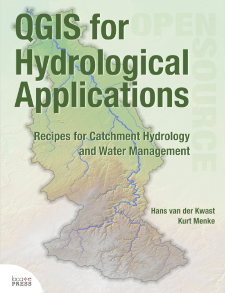

Locate Press
source link: https://locatepress.com/hyd
Go to the source link to view the article. You can view the picture content, updated content and better typesetting reading experience. If the link is broken, please click the button below to view the snapshot at that time.
QGIS for Hydrological Applications
Recipes for Catchment Hydrology and Water Management
by Hans van der Kwast and Kurt Menke

PDF $34.99
168 pages
ISBN 978-0998547787
Print available 2019-09-19
Learn GIS skills for catchment hydrology and water management with QGIS for Hydrological Applications!
This workbook introduces professionals in the water sector to the state of the art functionality of QGIS 3.x for hydrological applications. The book can also be used as a beginner’s course introducing GIS concepts in a problem based learning manner.
Designed to take advantage of the latest QGIS features, this book will guide you in improving your maps and analysis.
With this book you'll learn to:
- Georeference scanned maps
- Digitize vectors
- Import tabular data
- Join attribute tables
- Interpolate points to a raster
- Apply map algebra
- Delineate streams and catchments
- Find and use Open Data
- Calculate the percentage of land cover per subcatchment
Design beautiful catchment maps
In addition to the core functionality of QGIS, you’ll be introduced to many useful plugins.
The book is a complete resource and includes:
- Lab exercises
- Discussion questions
Links to videos with theory and explanations of the exercises
By purchasing the book you support the attendance of students at FOSS4G and QGIS events.
Contents
Foreword
About This Book
1 Preparing Data from Hardcopy Maps
1.1 Introduction
1.2 Choosing the Projection
1.3 Enable the GeoreferencerGDAL Plugin
1.4 Importing the Scanned Map into the Georeference GDAL Plugin
1.5 Setting the Transformation Parameters
1.6 Adding Ground Control Points (GCPs)
1.7 Reduce Errors and Perform the Transformation
1.8 Verify the Georeferenced Map
1.9 Digitizing Vector Layers from a Georeferenced Backdrop
1.10 Styling the Mountains, Rivers, and Lakes
2 Importing Tabular Data into QGIS
2.1 Introduction
2.2 Check the Spreadsheets
2.3 Import Spreadsheets
2.4 Convert Spreadsheet to Vector Layer
2.5 Join Attribute Tables
2.6 Edit the Joined Attribute Table
2.7 Interpolate Point Features to Raster
2.8 Styling the Results
3 Spatial Analysis with Map Algebra
3.1 Introduction
3.2 Preparation
3.3 Condition 1: Wells within 150 Meters of Houses or Roads
3.4 Condition 2: No Industry, Mine, or LandÞll within 300 Meters from Wells
3.5 Condition 3: Wells Less than 40 Meters Deep
3.6 Combine the Three Conditions and Report the Results
4 Stream and Catchment Delineation
4.1 Introduction
4.2 Download DEM Tiles
4.3 Mosaic DEM Tiles
4.4 Reproject DEM
4.5 Subset DEM
4.6 Fill Sinks
4.7 Delineate Streams
4.8 Define Outflow Point
4.9 Delineate the Catchment
4.10 Storing the Data in a GeoPackage
4.11 Styling the Resulting Catchment Area
5 Adding Open Data to Your Catchment
5.1 Introduction
5.2 Adding Data from Web Map Services
5.3 Adding Vector Data from OpenStreetMap
6 Calculating Percentage of Land Cover per Subcatchment
6.1 Introduction
6.2 Preparing the Subcatchment Layer
6.3 Preparing the Land Cover Data
6.4 Intersect the Land Cover Layer with the Subcatchment Layer
6.5 Calculate Land Cover Class Area per Subcatchment
6.6 Create Pie Charts Using the Data Plotly Plugin
7 Map Design
7.1 Introduction
7.2 Map Design Considerations - Adding More Data
7.3 Styling and Labeling Cities and Towns
7.4 Creating a Catchment Boundary Layer
7.5 Setting up the Print Layout
7.6 Adding the Map
7.7 Adding a Title
7.8 Adding a Legend
7.9 Adding a Scale Bar
7.10 Adding a North Arrow
7.11 Adding Descriptive Text
7.12 Using Variables for Adding Your Name as Author
7.13 Setting up a Map Theme
7.14 Setting up the Layers for the Locator Map
7.15 Adding a Gradient Legend for Elevation
7.16 Final Adjustments
7.17 Exporting the Map
8 Conclusion
8.1 Things to Do
Index
Availability
- Ebook version: Available prior to FOSS4G Bucharest on August 23, 2019
- Print version: Pre-order now, available September 19, 2019
To keep up to date on this and our other books, subscribe to our low-volume newsletter.
Recommend
About Joyk
Aggregate valuable and interesting links.
Joyk means Joy of geeK